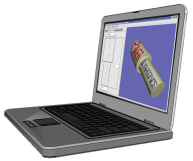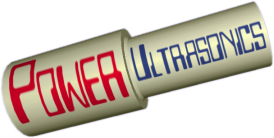A new online ultrasonics components store has just opened at www.UltrasonicsWorld.com. Check their amazing prices for replacement ultrasonics components, fully compatible with the major manufacturers' originals at a fraction of the cost.
You are here
How can I build horns with a lathe, drill press..?
1 July, 2004 - 07:19 — morrisR
Dear Sir,
Young people think they know it all untill
oportunity knocks & then your get a reality
check. This happens to describe how I felt
when my boss decided to give me a bench model
Cavitron 20k Hertz Ultra sonic welder. Well
how does one learn to make custom horns and such? The old manual shows a device that checks horn design but of course this magic box is missing. How can I build horns with a lathe, drill press and mill equipment?
Forums:


Re: How can I build horns with a lathe, drill pres
Hello Morris,
You can certainly use your machine shop equipment, although titanium alloy is a bit of a pain to machine. You can't take small cuts because it chatters and gives a lousy finish, but taking large cuts can be scary, with burning swarf flying in all directions! You'll probably want to start with a high strength aluminum alloy - much more friendly.
But sorry, you really do need the magic box. Even the experts need to finalize sonotrode designs with a little trial and error - make it, check the frequency, machine it down a bit, check again until the frequency gets close enough to 20kHz.
Some generators have a frequency indicator that would help you (once you get close enough to let the generator work at all) but I'm guessing that an old Cavitron wouldn't have this...
Otherwise, for simple designs (like a stepped horn with a flat end, not too large in diameter) you might get away with dead reckoning - just make it exactly half a wavelength long with the step in the center. But for anything more complicated you'll need the specialist test equipment.
I think many of the generator manufacturers make test equipment too, at least for their own use, but don't seem to offer them for sale. Perhaps they prefer people like you to come to them for your sonotrodes... To be fair tho the design process can be very difficult for some sonotrode designs, particularly where any dimension other than the length exceeds a third of a wavelength (typically around 3" at 20kHz) - then you need finite element modeling as well as the test equipment. So I don't know of anyone currently supplying test equipment at reasonable prices. There are spectrum analyzers but they tend to be high-end lab equipment and from what you've said I don't think your budget would stretch to something like that.
You might try your local ultrasonic equipment supplier and see whether they'd be willing to help. If you do manage to find a source of "magic boxes" at reasonable prices I'd very much like to include it on my site.
Hope this helps
Regards
Chris Cheers
Re: How can I build horns with a lathe, drill pres
Dear Mr.Cheers,
Thank you for your most interesting respond.
You have a very interesting web site. I would like to
help you with any data I come across in the future.
Have you seen the DUKANE web site? It has much information.
I do have a lathe/mill machine at home and would like to try out a simple horn design. Your notes for a simple horn design may prove to be of much help. Could you help me with understanding how to make it half the wavelength long? Were would you get the other half measurement from?
The Cavitron did come with one horn. It is a aluminum design. It fused a 3 1/2 X 2 1/4 plastic box cover onto a plastic box. The fuse was on the bottom surface on the horn. Could the dimensions
of this horn be of any help to me?
Awaiting your reply,
Morris
Re: How can I build horns with a lathe, drill pres
Hello Morris,
I've been in contact with Dukane in the past but hadn't checked their web site recently - there is indeed a horn analyser in the products section:
[url]http://www.dukcorp.com/us/products/thermo/plastics/40a350.htm[/url]
The half-wavelength as a length dimension refers to the sound wavelength in the horn material. Basic physics gives us:
wavelength = (sound velocity) / (frequency)
and
sound velocity = square root ((Young's Modulus) / (density))
so you need to get figures for Young's Modulus and density for the aluminium alloy you're proposing to use (I wouldn't recommend machining titanium on anything but serious industrial equipment).
The figures for the particular high-strength aluminium alloy we used (L168 - an aircraft grade) were:
Modulus 74e9 Pa
Density 2800 kg/m3
giving sound velocity 5140 m/s and wavelength 0.257 m at 20kHz.
Hence the length of a simple stepped sonotrode should be 128.5 mm.
Other aluminium alloys are fairly similar - half wavelengths typically in the range 125 to 130 mm at 20kHz.
One of the ideas for my new website is a little calculator to do this sort of thing...
As I said, you can use this sort of dead-reckoning approach for very simple horn shapes but you may still need to tune the frequency of the finished horn. For more complex designs this is just the starting point, with finite element analysis and possibly several prototypes required to get to a finished design.
The dimensions of the existing horn won't really help unless you're making another just like it (even the you might find that differences in material properties could demand different dimensions).
Good luck!
Regards
Chris Cheers
Re: How can I build horns with a lathe, drill pres
Hello Mr.Cheers,
Thank you for your very useful information.
I would like to encourage you to continue with
your web site ideas.
I do understand the half wavelength dimension now.
My next question is,
The square root(Youngs Modulus), is this a table?
Also, have you ever noticed the top of the horn designs
have a radius from the edge of the piece to the top.
I call it a bell shape. Then, others don't have this.
Is this a vital part of the design?
Your e-mail address ends with au, your country is?
I am located in Rhode Island USA.
Happy 4th of July!
Morris
Re: How can I build horns with a lathe, drill pres
Thanks for the encouragement!
Young's Modulus is a physical property of elastic materials - a measure of the stiffness, or resistance to deformation. Square root is the mathematical function. ie. the formula could be:
Sound velocity squared = Young's Modulus divided by density.
This might explain it better (you'll find lots more information via Google etc):
[url]http://www.frontiernet.net/~jlkeefer/sound.htm[/url]
The precise shape of the ends of a sonotrode are not usually vital, although for larger / more complex shapes anything is possible. But on a stepped sonotrode you'll find almost universally a radius into the central step leading out from the smaller diameter - this is vital since it's a high stress area and a sharp corner would be a bad stress raiser.
I'm in Australia, about 80 miles north of Sydney.
Happy 4th of July to you too!
Regards
Chris Cheers
Re: How can I build horns with a lathe, drill pres
Hello Mr.Cheers,
Thank you for your last e-mail. You have been very informative.
Check out this web site: [url]http://www.tomantool.com[/url]
They have a frequency sniffer that is hand held, and runs on 9 volts
batteries.
Lots of other goodies too!
Keep up the good work,
Morris Rush
Re: How can I build horns with a lathe, drill pres
Morris,
Thanks for that - I'll certainly add Toman to the list, but their frequency sniffer isn't a horn analyzer. You can get similar devices from RS and other electronics suppliers - they just measure the frequency in electrical signals radiated by other equipment. In this context you would be relying on your existing ultrasonic generator to provide the high frequency supply, and if your horn is outside the working range of the generator then it won't work, and the sniffer won't tell you why.
A real horn analyzer (like the Dukane one discussed earlier) contains a low power variable frequency generator which you can adjust yourself to any frequency you like, as well as a frequency indicator and something to measure the response of the horn. It would be a lot more expensive than a frequency sniffer but also much more useful, particularly if you plan to attempt more complex horn designs.
Regards
Chris Cheers
Re: How can I build horns with a lathe, drill pres
(Post moved as new topic on Questions board)
Chris